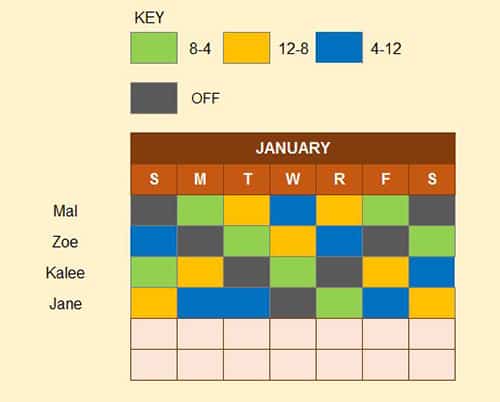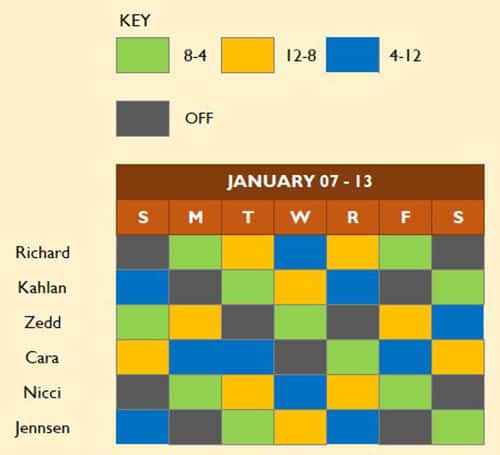How To Create A Weekly Schedule Template
Need to schedule your employees? Don’t reinvent the wheel every time. Let the ...

As a manager, does it seem like some parts of your job are never done? You look around and think, “I just did that!” Then you have to carve time out of your busy schedule and take time away from more important issues to repeat tasks over and over again.
Few things in a manager’s work life are as repetitive as employee scheduling. But despite the need to constantly schedule, there is a way to simplify the process so that it’s not as difficult or time-consuming as it once was.
How is that possible? With the help of an employee schedule template, also known as a staff scheduling template.
We’re here to show you how this kind of template can free up your time so you can deal with more important managerial problems, like accounting, interviewing, marketing, and hiring. Along the way, we’ll address such issues as:
We’ll also show you how to use your computer or mobile device to harness the power and versatility of advanced software to make the scheduling process easier than ever.
Before we do that, though, let’s discuss why it’s important to have an employee schedule template in the first place.

Why should you create a standard employee schedule template for your business? Because your employee schedule is a reflection of the needs of your company and the employees who work there.
As such, the information on your employee schedule may be completely different from the information on another business’s employee schedule.
For example, your employees may perform different jobs on different days. Not every template will reflect that change. You’ll need to design one that does.
A custom-made employee schedule template also reduces the amount of time you have to spend preparing before you get to the actual task of scheduling. You’ll no longer have to remake the calendar every single time.
Instead, your custom employee schedule template is stored on your computer or in a filing cabinet so that all you have to do is fill it out.

At its most basic, your employee schedule template should include the following information:
The employee names, dates, business hours, and contact information should be printed on the periphery of the schedule. That way, the only information on the calendar itself is the work hours.
If possible, we also suggest formatting your employee schedule as a table and making use of color coding and images (of employees) to make it easy to read.
However you choose to format your employee schedule, keep the template simple. It should only take a few seconds for an employee to figure out:
If it takes longer than a minute to decipher that information, your employee schedule template is too complicated.
Here’s an effective way to test the simplicity of your employee schedule:
You should be able to figure out that employee’s schedule for the next week in 30 seconds or less. If you can’t do that, your template needs to be simplified.

The easiest way to create your own simple employee schedule template, like the one shown above, is to use Microsoft Excel or another spreadsheet program. It may take a bit of time to get everything exactly the way you need it, but the scheduling process will be simpler going forward.
There are hundreds of templates online, and a simple search for “employee schedule template” will reveal a number of useful options. Most will need to be modified to best suit your needs. Here’s how to do that.
Get creative with this process and we’re sure you’ll develop an employee schedule template that is perfect for your business.

Once you’ve finalized your scheduling template and are ready to put it to use, there are several key tips to remember that will make your job easier.
Making this fact the cornerstone of your scheduling process means that you’ll always have a core of experience on every shift. Because of that, you can be confident that the shift will run smoothly and your less-experienced employees can learn from their more-experienced teammates.
This includes knowing what their strengths and weaknesses are. This will make it easier to put the right person in the right shift. It also helps you know when your employees can and cannot work. That brings us to the next variable.
Doing so serves to create a sense of goodwill among your employees. It also increases employee engagement and satisfaction, which can help you retain good workers longer.
When your employees know that they can get a day off to handle personal issues, they’re less likely to start looking for a different job that will fit their schedule better.
Work/life balance is crucial for your employees’ overall happiness. If you hold the employee schedule back until the last minute, they won’t have a chance to plan their personal activities. Their job satisfaction will decrease and your business will suffer.
Distributing the employee schedule as soon as it’s available also gives you plenty of time to make changes before the shifts go into effect. That will save you extra work and added stress later on by avoiding last-minute substitutions and no-call, no-show employees.
Providing your employees the opportunity to pick their own shifts is a great way to keep them engaged and allows them to tailor their schedules around other parts of their personal lives.
If letting your employees have free rein when it comes to scheduling makes you nervous, try scheduling one or two of your best employees (see variable #1) on each shift, and then give the other employees the chance to fill in around them.
After a few days, review the choose-your-own-shift schedule, make any necessary changes, then finalize it and send it out.
If that sounds complicated, it’s really not…with the right tools, of course. Scheduling apps like Sling allow you to create a master template that everyone can access online. There, they can choose their shifts and fill in around the set employees you scheduled.
Then you can close the document (so they can’t make any more changes), switch things up if necessary, and then make it available to your employees again.
Without an efficient system in place, finding a substitute for an employee who can’t work can be a time-consuming chore. You immediately have to start calling your employees who aren’t working to see if they are willing to cover another shift.
And chances are, you may not find anyone who is available to come in, so your shift is still short-staffed. That’s a big waste of time during which you could be focusing on more important tasks.
So instead of doing all the work yourself, give your employees the responsibility of finding their own substitute to cover their shift when they can’t work. This is an effective way to make sure you have enough employees on the job at a given time, but it does require two key things:
A quick and easy communication network is the foundation for finding substitutes. Whether it’s you or your employees reaching out, calling each person individually takes precious time that could be better spent elsewhere.
The better solution is to establish a communication network based on text messaging or push notifications. Modern scheduling apps let you send one instant message to everyone associated with your business, or a specific group.
Employees can use this network to broadcast the need for a substitute. Employees who are willing to work can also use it to respond and volunteer for the shift.
In regard to guidelines for choosing replacements, here are two crucial principles that every employee handbook should contain:
With those guidelines in place, you can be sure that giving your employees the responsibility of finding their own substitutes will be productive.
If you’ve ever tried to drive a nail with a screwdriver, you know the importance of using the best tools for the job at hand. Creating a work schedule is no different — the right tools can make the job easier and quicker to complete.
Even tools meant for other purposes (like Word or Excel) can streamline the process of creating an employee schedule template when compared to the age-old pen-and-paper method.
And now, with cloud computing spreading to every corner of the business world, free online versions of Word and Excel (e.g., Google Docs and Sheets) make the process even simpler.
So while you may already be using one or the other of these programs, is it really the best fit for the job? Is there a better option available? Yes, there is.
Special tools — like Sling — are specifically tailored to scheduling employees and creating employee schedule templates for businesses in industries like:
These apps contain powerful features that help make building your employee schedule template easier than ever before.
Because this software is created specifically for scheduling, there is no complicated formatting necessary to get the template and the schedule looking the way you want it.
There’s no endless searching for a template that doesn’t quite work. There’s no trying to figure out a way to do something with a program that is made for a different purpose. All you have to do is focus on making the best schedule possible.
Sometimes, an employee can’t find a substitute to cover their shift. When that happens, it’s up to you to find someone to work. It’s times like those when an availability chart makes the whole thing go so much smoother.
Emergencies will come up. It’s inevitable. But rather than leaving it all to chance, use an availability chart as your “plan B.”
The simplest version is just a list of each employee and what days and times they’re available to work. They may not be scheduled for all of those days and times and might be willing to pick up an extra shift here or there.
The more complicated version is another full schedule listing “on-call” employees who are available to work during each and every shift.
Ultimately, this simplifies the substitute process by taking the thought out of it. An availability chart can also reduce the stress involved when the need for a last-minute substitute arises.
No matter how carefully you plan your employee schedule template, something may still go wrong.
So even though you’ve got your availability chart that outlines employees who are available to work on short notice, you may need a backup to this backup — or a plan C to your plan B.
We recommend setting up a list of trusted and reliable part-time workers you can contact when all of your other options have failed.
These workers may be former employees who left on good terms or prospective employees who were interviewed but didn’t get hired. You may think these people would never be willing to come in on such short notice, but you never know until you ask.
Communication is vital in any business. When it comes to scheduling, it can mean the difference between having enough employees to cover a shift and being short-staffed.
Establishing a team-wide communication method makes it easy for you and your employees to know exactly where to look for your work schedule.
There’s no more searching through email, instant message, and texting apps to find the newest work schedule or that time-off request you need. Everyone uses the same tool, so everyone’s on the same page.
We recommend setting up a team-wide communication method right away. With most people using smartphones these days, your best bet is to choose a method that makes use of this ubiquitous technology.
Texting is one such method. Instant messaging is another. But even those quick and easy communication methods still come with a long list of difficulties.
A better option is an app like Sling. These software programs couple powerful scheduling tools with equally powerful communication features. This allows you to improve internal communication through push notifications, chatting, and photo sharing.
Plus, all of the information is stored in one place. If an employee asks for a day off, the app automatically links that request to the employee in question.
Then, when you go to access your employee schedule template and produce an actual work schedule, the software reminds you not to schedule the employee that day.

When building your employee schedule template, it can be very tempting to try to pack as much information into the final rota as possible. But too many letters and numbers are just as bad as too few.
If, when you fill in the template, it looks like a wall of text, the final schedule is going to be a challenge to read. Reduce the amount of text on your template by color-coding one or two major variables.
If you printed the time range worked (e.g., 8-4, 4-12, and Off) in each box, the template and final schedule would likely be much more cluttered and complicated.
For example, a simple schedule with letters and numbers might look like this:

At first glance, the sheer amount of text may feel a bit overwhelming to your employees. Instead, color code the hours worked to make the final schedule feel more approachable.
Here’s a variation of the schedule above (and the one we used in the How To Create An Employee Schedule Template section) that illustrates how you can use color instead of letters and numbers to make the final staff rota easier to read and decipher.

By color-coding the time worked variable, you can pack a lot of information into a small space and communicate it quickly to your employees.
Or, instead of color-coding the shifts, you could assign each team member a color of their own, format the template to include more blocks (the shifts themselves), and then fill in the employee colors accordingly.
The final schedule would look similar to the one above, but the colors would represent individual team members instead of hour ranges.
This may seem like an unimportant tip, but maintaining a blank copy of your employee schedule template can save a lot of time in the long run.
Imagine that you open an old schedule to serve as the template for a new schedule. Sure, you might be able to use a bit of the information, but you’ll likely have to delete a good deal of it before you get started.
That wastes time.
Instead, open a copy of the template and a completed copy of the schedule to serve as a reference. Then, copy and paste from one to the other or fill in new information as necessary.
Saving a blank copy of the employee schedule template also serves to preserve any changes you might make to the format or layout.
If you make the changes in one version of the completed schedule, but forget to make them in the next version, those improvements may be lost and forgotten.
Once you’ve got the template formatted the way you want it, save it with a descriptive name that is different from the names you give to your finished schedules.
For example, if you save your schedules as 2022_10_OCT_Employee Work Schedule, save the template as something completely different — like Employee_Schedule_Template.
Then, when you sit down to build a new rota, open the template, save it under a new name (e.g., 2022_11_NOV_Employee Work Schedule), and start assigning team members to shifts.
That way (as we mentioned at the beginning of this tip), you won’t write information in the template that doesn’t belong in each and every finished schedule.

A Gantt chart might be the perfect way to manage the various projects in your business, but it might not be the best choice for an employee schedule template.
Your team may be used to reading a Gantt chart to track work activity, but they’re probably not used to reading it to figure out when they work next.
Using an unfamiliar format for your template — and the final schedule on which it’s based — makes the process more difficult for your employees.
Creating an employee work schedule is, after all, all about communication. To make the communication as clear and as straightforward as possible, choose a familiar format for your template.
One of the most familiar methods for communicating dates and times is a calendar. There’s a high chance that your team members have been reading calendars in one form or another for most of their lives.
In other words, they’re used to extracting information from calendars. As a result, finding when they work will be easier — and less prone to mistakes — if you present the information in this format.
That’s not to say that your employee schedule template has to look exactly like a calendar, but building it so that information is arranged as a table (with rows and columns) is a good start.
No employee schedule template should be set in stone. At least once a year, take the time to review and reevaluate the template you’ve been using and make any changes that improve its usefulness and usability.
Even small changes that, at first glance, may seem inconsequential can have a significant effect on the process you use to organize your team and the final schedule you’re trying to produce.
When you do make changes to the template, save a new copy under a different name (perhaps with a date, Revision 01, or some other mark that distinguishes it from the original template).
That way, if a certain tweak doesn’t work out the way you thought it would, you can start over with the original template — without having to recreate it from memory — and try something different.
Once you have the revised template the way you like it, get a different perspective by asking your employees for suggestions on how they would improve the schedule as a whole.
Transfer the best ideas to your employee schedule template so the final schedule you produce is the best it can be.

A simple employee schedule template is ideal for getting started. It can reduce the headache of scheduling somewhat, but it still leaves much to be desired. This rudimentary employee schedule template does nothing to help with:
Only one solution does all that and much more: Sling.
Sling is an employee scheduler designed to bring order to the chaos. It simplifies all of the issues that a manager could potentially face when scheduling employees. Plus, Sling users get free access to staff scheduling templates, and it’s easy to create and customize your own.
But Sling is about more than just plugging names into time slots. It’s about making every aspect of your job — scheduling, distribution, communication — easier and faster.
Sling’s integrated features (Shifts, Time Clock, Messages, Newsfeed, Tasks) reduce the time it takes to create and manage your business’s schedules and employees.
In fact, Sling helps managers bring teams together, keep everyone informed and engaged, and build a better work culture.
Don’t reinvent the wheel every time you create an employee schedule. Instead, let Sling show you how easy scheduling can be. Visit GetSling.com today to try the Sling app for free.
See Here For Last Updated Dates: Link
This content is for informational purposes and is not intended as legal, tax, HR, or any other professional advice. Please contact an attorney or other professional for specific advice.
Schedule faster, communicate better, get things done.